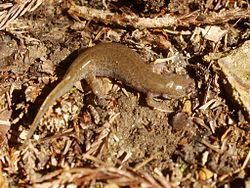ar
الأسماء في صفحات التنقل


Hynobius nebulosus, the Mitsjama salamander, is a species of salamander in the family Hynobiidae endemic to Japan. Its natural habitats are temperate forests, rivers, swamps, freshwater springs, and irrigated land. It is threatened by habitat loss.
Hynobius nebulosus, the Mitsjama salamander, is a species of salamander in the family Hynobiidae endemic to Japan. Its natural habitats are temperate forests, rivers, swamps, freshwater springs, and irrigated land. It is threatened by habitat loss.
La salamandra nebulosa del Japón (Hynobius nebulosus), es una especie de anfibio caudado de la familia Hynobiidae. Es endémica del Japón. Su hábitat natural son los bosques templados y los ríos y marismas.
La salamandra nebulosa del Japón (Hynobius nebulosus), es una especie de anfibio caudado de la familia Hynobiidae. Es endémica del Japón. Su hábitat natural son los bosques templados y los ríos y marismas.
Hynobius nebulosus Hynobius generoko animalia da. Anfibioen barruko Hynobiidae familian sailkatuta dago, Caudata ordenan.
Hynobius nebulosus Hynobius generoko animalia da. Anfibioen barruko Hynobiidae familian sailkatuta dago, Caudata ordenan.
Hynobius nebulosus est une espèce d'urodèles de la famille des Hynobiidae[1].
Cette espèce est endémique du Japon. Elle se rencontre jusqu'à 300 m d'altitude dans le sud de l'île de Honshū, sur Shikoku, dans le nord de l'île de Kyūshū[1].
Hynobius nebulosus mesure de 40 à 70 mm sans la queue et de 70 à 125 mm de longueur totale[2].
Hynobius nebulosus est une espèce d'urodèles de la famille des Hynobiidae.
Hynobius nebulosus (Temminck & Schlegel, 1838) è un anfibio della famiglia Hynobiidae endemico del Giappone.[2]
Il suo ambiente naturale sono le foreste temperate, le paludi e i fiumi; la popolazione è in decrescita.[1]
Hynobius nebulosus (Temminck & Schlegel, 1838) è un anfibio della famiglia Hynobiidae endemico del Giappone.
Il suo ambiente naturale sono le foreste temperate, le paludi e i fiumi; la popolazione è in decrescita.
Hynobius nebulosus é uma espécie de anfíbio caudado pertencente à família Hynobiidae. Endêmica do Japão.
Hynobius nebulosus é uma espécie de anfíbio caudado pertencente à família Hynobiidae. Endêmica do Japão.

 分類 界 : 動物界 Animalia 門 : 脊索動物門 Chordata 亜門 : 脊椎動物亜門 Vertebrata 綱 : 両生綱 Amphibia 目 : 有尾目 Caudata/Urodela 科 : サンショウウオ科 Hynobiidae 属 : サンショウウオ属 Hynobius 種 : カスミサンショウウオ
分類 界 : 動物界 Animalia 門 : 脊索動物門 Chordata 亜門 : 脊椎動物亜門 Vertebrata 綱 : 両生綱 Amphibia 目 : 有尾目 Caudata/Urodela 科 : サンショウウオ科 Hynobiidae 属 : サンショウウオ属 Hynobius 種 : カスミサンショウウオSalamandra nebulosa
Temminck & Schlegel, 1838[2]
カスミサンショウウオ(Hynobius nebulosus)は、有尾目サンショウウオ科サンショウウオ属に分類される有尾類。
日本(岐阜県以西の本州、四国北東部、九州北西部)固有種[3]
全長9.4 - 12.7センチメートル[3]。体側面に入る皺(肋条)は左右に13本(まれに12本)ずつ[3]。背面の色彩は緑褐色や淡灰褐色・暗褐色で、褐色の斑点が入る個体が多い[3]。種小名nebulosusは「雲状の」の意で、英名(clouded=雲の)と同義。尾の背面外縁に黄色い筋模様が入る個体が多い[3]。
上顎中央部に並ぶ歯の列(鋤骨歯列)はアルファベットの深い「V」字状[3]。胴体に沿って前肢(および指)を後方へ後肢(および趾)を前方に伸ばしても0.5 - 2肋条ぶんの隙間がある[3]。後肢の趾は5本[3]。
卵嚢の表面には明瞭な筋が入らない[3]。
広域分布種だが形態・遺伝的な地域変異が大きく、複数の隠蔽種を含んでいると考えられている[3]。
主に低地から丘陵にある湧水や水田の周囲にある二次林や竹林・草原などに生息するが、中国山地の個体群は標高の高い自然林にも生息する[3]。本州では同所的に分布するヒダサンショウウオ・ブチサンショウウオH. naeviusと垂直分布(標高)ですみ分けを行っているが、中国山地では同じ環境に生息することもある[3]。
昆虫、クモ、ワラジムシ、ミミズなどを食べる[3]。幼生は水生昆虫、ミジンコ、イトミミズなどを食べ、共食いも行う[3]。
繁殖様式は卵生。12 - 翌5月に浅い池沼や水田の溝、湿原、流れの緩やかな沢などに50 - 179個の卵を産む[3]。卵は3 - 4月以降に孵化する[3]。幼生は6 - 7月に変態し幼体になる[3]。
土地開発による生息地の破壊、それに伴う土砂流出による水質汚濁、減反政策による乾田の増加による繁殖地の減少、人為的に移入されたアメリカザリガニ・魚類などによる捕食などにより生息数は減少している[3]。京都府・愛媛県・岐阜県・滋賀県・奈良県では条例により許可のない捕獲が禁止されている[3]。